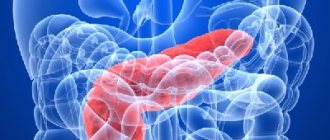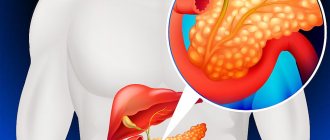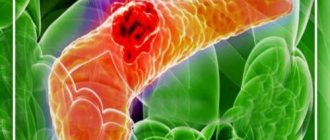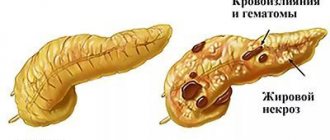Pancreatitis is a group of diseases characterized by inflammation of the pancreas tissue. Pancreatitis can be acute or chronic.
Chronic pancreatitis is a long-term inflammatory disease of the pancreas, in which irreversible morphological changes and dysfunction of the organ develop.
Chronic pancreatitis is a fairly common disease, affecting both men and women; more often middle-aged and older people. Unfortunately, recently there has been an increase in the number of patients with chronic pancreatitis.
Factors that can lead to the development of chronic pancreatitis:
- Toxic factors: alcohol consumption, smoking. Also toxic factors include a diet rich in fats and carbohydrates.
- Hereditary factors. Mutations of certain genes lead to the formation of hereditary chronic pancreatitis.
- Immunological factors.
- Obstruction (obstruction) of the pancreatic ducts.
In accordance with the causes of chronic pancreatitis, a classification has been developed, according to which toxic, idiopathic, hereditary, autoimmune, and obstructive chronic pancreatitis are distinguished.
Chronic pancreatitis clinic
The main clinical symptom of chronic pancreatitis is pain predominantly in the upper abdomen, which can radiate to the back. Abdominal pain intensifies after eating, may be present constantly or increase in paroxysms. Violation of the secretion of digestive enzymes is manifested by nausea and bloating. Over time, weight loss may occur. Manifestations of hypovitaminosis are rare - dry skin and mucous membranes, skin rash, brittle nails, hair loss.
Chronic pancreatitis is usually divided according to the stages of development of the inflammatory process. Determining the stage affects the prognosis of the disease and the choice of treatment tactics.
Stage I – preclinical. At this stage, symptoms of pancreatitis are not yet observed. Changes in the pancreas can be detected only by examining the abdominal organs using instrumental methods - ultrasound (ultrasound) or magnetic resonance imaging (MRI).
Stage II – the stage of initial manifestations, characterized by the presence of abdominal pain. Attacks of acute pancreatitis may occur. The second stage can last 5-7 years.
Stage III – stage of persistent symptoms. Distinctive features of this stage are increased abdominal pain, spreading to the back. A dysfunction of the pancreas develops: the production of enzymes and hormones (insulin, glucagon) decreases.
Stage IV – stage of pancreatic atrophy. At this stage, abdominal pain becomes less pronounced, attacks of acute pancreatitis disappear. Signs of diabetes mellitus appear and the risk of developing pancreatic cancer increases.
A comprehensive analysis that includes all the necessary laboratory markers of pancreatic function and is intended for the diagnosis of acute and chronic pancreatitis.
Synonyms Russian
Laboratory markers of pancreatitis, laboratory examination of the pancreas.
English synonyms
Laboratory pancreas panel, Tests to diagnose pancreatitis, Pancreas check-up.
What biomaterial can be used for research?
Venous blood.
How to properly prepare for research?
Eliminate alcohol from your diet for 24 hours before the test.
- Children under 1 year of age should not eat for 30-40 minutes before the test.
- Children aged 1 to 5 years should not eat for 2-3 hours before the test.
- Do not eat for 12 hours before the test; you can drink clean still water.
- Completely avoid (in consultation with your doctor) taking medications for 24 hours before the test.
- Avoid physical and emotional stress for 30 minutes before the test.
- Do not smoke for 30 minutes before the test.
General information about the study
The pancreas secretes hormones and synthesizes digestive enzymes and is thus both an endocrine and an exocrine gland. Many factors (gallstones, alcohol, blunt abdominal trauma) have a negative effect on the pancreas and lead to the development of pancreatitis. There are two main forms of this disease: acute and chronic pancreatitis. Both forms of the disease are manifested by dysfunction of the pancreas, which is accompanied by deviations from the norm of several clinical and laboratory markers. A comprehensive assessment of these clinical and laboratory markers is used in differential diagnosis and assessment of the severity of pancreatitis.
Lipase is a pancreatic enzyme necessary for the breakdown of fats. It is formed only in the pancreas and is a specific marker of this organ. A significant increase in blood lipase levels (usually more than 3 times) is observed in 90% of cases of acute pancreatitis. In chronic pancreatitis, lipase levels may remain within normal limits. It should be noted that lipase is not a specific marker for pancreatitis. An increase in lipase concentration can be observed, for example, in pancreatic cancer.
Amylase is another pancreatic enzyme necessary for the breakdown of carbohydrates. A significant increase in amylase is observed in acute pancreatitis. It should be noted that amylase is a less specific marker of pancreatitis than lipase. Elevated amylase may also occur with many other conditions, including hyperthyroidism, lung cancer, salivary gland disease, and certain medications. In chronic pancreatitis, amylase levels may remain within normal limits. A simultaneous increase in lipase and amylase is very characteristic of acute pancreatitis. Lipase levels remain elevated longer than amylase levels. The rate at which lipase and amylase levels normalize depends on the severity of pancreatitis and can therefore be used to assess the prognosis of the disease.
The pancreas is closely related to the liver and bile duct system. Therefore, diseases of the liver and biliary tract often lead to pancreatitis. In fact, the most common cause of acute pancreatitis is cholelithiasis and gallstone blockage of the sphincter of Oddi. If pancreatitis develops against the background of cholelithiasis (biliary pancreatitis), an increase in liver enzymes (ALT, AST) and bilirubin is often observed. In patients with characteristic clinical symptoms of pancreatitis, an ALT level exceeding 150 U/L indicates biliary pancreatitis.
The pancreas plays a leading role in glucose metabolism. Often in acute and chronic pancreatitis, pancreatic insufficiency is observed, which is manifested by impaired insulin synthesis and hyperglycemia. Impaired glucose tolerance is observed in 9-70% of cases of acute pancreatitis. Glucose concentration above 200 mg/dL is one of the criteria for assessing the severity of acute pancreatitis (according to the Renson scale). As a rule, hyperglycemia in acute pancreatitis is transient. In contrast, more than 80% of patients with long-term chronic pancreatitis eventually develop diabetes mellitus.
General clinical tests are also used to assess the severity of pancreatitis: complete blood count and leukocyte count. Using a general blood test, you can obtain important information that allows you to judge the degree of fluid sequestration (hematocrit) and the development of disseminated intravascular coagulation (platelet count). A drop in hematocrit by 10% and leukocytosis above 16,000*109/l is one of the criteria for assessing the severity of acute pancreatitis (according to the Renson scale).
The coprogram is also a useful additional test to help diagnose pancreatitis. This test is of greatest importance in the diagnosis of chronic pancreatitis; it is accompanied by a deficiency of digestive enzymes of the pancreas, including amylase, lipase, chymotrypsin, trypsin and others. A deficiency of these enzymes leads to disruption of the breakdown of sugars, fats and proteins in the digestive tract and the appearance of characteristic changes in the coprogram.
Laboratory methods are important, but not the only diagnostic tests that are needed to make a diagnosis of pancreatitis.
What is the research used for?
- For the diagnosis of acute and chronic pancreatitis.
When is the study scheduled?
- During a preventive examination of the patient;
- when examining a patient with risk factors for pancreatitis: cholelithiasis, alcohol abuse, previous abdominal trauma, diagnostic procedures on the pancreas (for example, ERCP), taking certain medications (azathioprine, didanosine, valproic acid) and others;
- in the presence of symptoms of acute pancreatitis: abdominal pain of varying intensity radiating to the back, nausea, vomiting, fever, jaundice;
- in the presence of symptoms of chronic pancreatitis: constant or recurrent abdominal pain, loss of appetite, nausea, vomiting, bloating, constipation, weight loss, steatorrhea.
What do the results mean?
Reference values
For each indicator included in the complex:
- [02-005] Clinical blood test (with leukocyte formula)
- [06-003] Alanine aminotransferase (ALT)
- [06-005] Serum total amylase
- [06-015] Plasma glucose
- [06-027] Lipase
- [06-036] Total bilirubin
- [06-182] C-reactive protein, quantitative (method with normal sensitivity)
How is chronic pancreatitis diagnosed?
Examination of a patient with signs of chronic pancreatitis includes instrumental and laboratory methods.
Ultrasound examination, magnetic resonance imaging, computed tomography of the pancreas allow you to visually assess the condition of the organ.
Laboratory research methods help assess pancreatic function and indirectly suggest a diagnosis of chronic pancreatitis.
- General stool analysis.
- Pancreatic elastase-1 (in feces) is an indicator for assessing the ability of the pancreas to produce digestive enzymes.
- Pancreatic amylase (in blood serum). An increase in enzyme activity indicates the presence of pancreatitis.
- Lipase (in blood serum). With pancreatitis, the level of lipase in the blood increases.
- Alpha-1 antitrypsin (in blood serum) is an indicator that is used to monitor the severity of the inflammatory process and the effectiveness of therapy.
How material is collected for research
For a biochemical blood test, exclusive venous blood is taken from the cubital vein. The procedure is performed by a trained healthcare professional under sterile conditions. The patient sits on a chair, extends his arm forward and it is clamped with a tourniquet 3 cm above the elbow.
The injection site is treated with an antiseptic and a puncture is made, followed by blood sampling into a test tube. After receiving the required amount of biomaterial, the puncture site is disinfected with a cotton ball soaked in antiseptic, and the arm is bent tightly at the elbow.
How to relieve pain from pancreatitis
This is necessary to reduce the risk of developing a hemotoma to a minimum, and the blood will clot faster. Test results are usually ready the next day.
They are performed in any laboratory equipped with special reagents and equipment.
Experts recommend donating blood for biochemistry if there are patient complaints or after a visual examination. Based on the results obtained, they make a diagnosis and prescribe effective treatment. After therapy, you should donate blood again to assess the quality of treatment.
Treatment of chronic pancreatitis
A gastroenterologist treats chronic pancreatitis.
Quitting smoking and drinking alcohol has a pronounced positive effect. An obligatory part of treatment is following a diet - “Table No. 5” - with a reduced amount of fats and simple carbohydrates. Painkillers, enzyme preparations, and antioxidants are also prescribed.
Acute pancreatitis is an acute inflammation of the pancreas, which can cause damage to nearby tissues and other organs.
The clinical picture of acute pancreatitis always develops quickly. The main symptoms are sharp pain in the abdomen, which can radiate to the back; repeated vomiting; muscle tension in the upper abdomen. Abdominal pain is usually very severe and does not decrease after taking painkillers and antispasmodics.
Clinical manifestations of pancreatitis
This disease manifests itself differently:
- in a painful form, and it can be considered as classic:
- usually the pain appears above the stomach and radiates from behind to the back;
- Shingles pain syndrome is less common;
- painful sensations in the right or left hypochondrium. The localization of pain is determined by which part of the pancreas is affected by the inflammatory process.
Often, an attack of pain is provoked by drinking alcohol, eating a lot of fatty and spicy food. And in order to stop this attack, you have to resort to strong and even narcotic painkillers. Recurrent chronic pancreatitis resembles acute pancreatitis in its manifestations, but often without much pain.
The latent form is characterized by the absence of pain. This is where her cunning lies. After all, a feeling of pain is a signal of a problem in one or another organ. Because while there is no pain, people continue to lead their usual lifestyle, not paying attention to other symptoms, or filling them with pills. But the disease rarely manifests itself in its latent form.
Patients often complain of nausea and reluctance to eat, provoked by involuntary contractions of the muscle tissue of the duodenum, or inflammatory processes in its mucosa. Belching and vomiting are observed. Intestinal function is impaired.
Reactive pancreatitis
Reactive pancreatitis is an acute condition with symptoms similar to acute pancreatitis. Occurs more often in children. The reason may be eating new foods or dishes, taking any medications (antibiotics). Reactive pancreatitis is characterized by abdominal pain after eating, nausea, and vomiting.
Diagnosis and treatment of reactive pancreatitis are the same as for acute pancreatitis.
Bibliography.
- Recommendations of the Russian Gastroenterological Association for the diagnosis and treatment of chronic pancreatitis, 2014.
- Clinical recommendations of the Russian Society of Surgeons for the diagnosis and treatment of acute pancreatitis, 2015.
- Collection of methodological materials of the “Russian Society of Surgeons” Acute pancreatitis, 2015.
Enzymes
When the pancreas is destroyed, the levels of some enzymes increase sharply.
Amylase
Amylase level is the first and main parameter that helps determine the development of pancreatitis. Usually there is a sudden release of the enzyme into the blood. Already in the first hours of exacerbation, indicators exceed tens of times. Everything is done cyclically - after 5 days from the moment of exacerbation, the indicator returns to normal.
Amylase and diastase do not always indicate the development of the disease in question. The enzyme presented is also produced by the salivary glands. Sometimes indicators behave extremely unpredictably. In the chronic form, a decrease in performance may be observed. This usually occurs when the organ is deeply damaged.
Lipase
Lipase is responsible for the breakdown of fats. The enzyme enters the intestines, where it promotes digestion. Its content in the blood is usually 20 thousand times less than in pancreatic juice. An increase in lipase in blood tests indicates improper digestion of food and increased cholesterol. The color and structure of stool also changes. In the acute form of the disease, lipase levels increase on the second day.
Protease
To break down protein foods, an enzyme called protease is produced. In case of disturbances in the pancreas, the presented element enters the blood instead of the intestines. This leads to the following changes in its chemical composition:
- In acute forms, trypsin increases from 12 to 70 times already on the first day of illness, but within a few days it quickly decreases to normal levels. As for the chronic form, there is a decrease in trypsin. This is due to the death of gland cells.
- Elastase levels increase and remain at this level for 101,004 days. After some time, the levels of all enzymes, except elastase, return to normal. The higher the concentration, the higher the damage to the organ. Therefore, it is necessary to pay special attention to the characteristic under consideration. Sometimes the disease can be determined using a stool test.
Conducting a survey
Diagnosis of pancreatic diseases is one of the difficult tasks of modern medicine. The diagnosis can be established on the basis of anamnesis, clinical pathology, and data from instrumental examination methods.
- Collection of complaints and medical history. Particular attention should be paid to complaints of abdominal pain, nausea, belching, thirst, sudden weight loss, a history of cholelithiasis, a family history of diabetes, etc.
- Inspection. It is necessary to pay attention to the patient’s constitution and skin color.
- Palpation. Normally, the organ is not palpable. When palpated, cysts and swellings can be detected if they reach large sizes.
- Laboratory research. Among the laboratory tests that are important in the diagnosis of pancreatic diseases, the following should be noted:
- examination of duodenal contents (allows you to determine the amount of enzymes);
- examination of stool (color, presence of undigested muscle fibers, etc. matter);
- blood and urine tests.
- Ultrasonography. This is the most accessible and painless method that allows you to conduct an informative examination. Using ultrasound, it is possible to determine the size of an organ, evaluate its structure, identify areas of increased or decreased echogenicity, and determine the diameter of the Wirsung duct.
- CT scan. It is a modern high-tech diagnostic method that is highly informative and allows one to identify pathology in cases where other studies do not produce results.
- The method also allows you to determine the shape and size of the organ, evaluate its structure, identify the presence of even small formations, and also determine the condition of the ducts.
- Endoscopic cholangiopancreatography. This method of radiological diagnosis of pancreatic diseases combines endoscopy and x-ray examination, allows you to study the condition of the ducts, identify the presence of stones and strictures.
- Biopsy. More often, fine-needle aspiration biopsy is used under ultrasound or CT control; it involves taking a piece of organ tissue and then performing a histological examination. Allows you to establish an accurate morphological diagnosis.
The listed examination methods make it possible to determine the anatomical and histological features of tissues and identify dysfunctions, therefore they are used for the differential diagnosis of pancreatic pathologies, allowing the detection of pathology in the early stages.
You can get advice and make an appointment (24 hours a day) by calling:
+7
Analysis of urine
A biochemical urine test is informative in diagnosing pancreatitis. The color of urine becomes a sign of the disease: the light yellow color changes with inflammation to dark yellow or brown. In urine analysis, an increase in diastase is observed. The more active the inflammatory process, the sharper the level of total amylase in the urine rises. This indicator is characteristic not only of acute pancreatitis; amylase in the urine also increases in diabetes mellitus.
Severe inflammation is accompanied by ketone bodies, leukocytes and red blood cells present in the urine. Protein is found in urine when its absorption in the intestine is impaired. In the acute course of the disease, urine must be taken repeatedly to monitor the dynamics of amylase in the body. Urinalysis in chronic gland disease shows a decrease in the level of α-amylase, which is associated with a weakening of the secretory functions of the gland during long-term pathology.
Prevention and recommendations
Prevention is based on eliminating risk factors that provoke the disease:
- timely treatment of diseases that provoke pancreatitis
- eliminating the possibility of chronic intoxication that contributes to the development of this disease (industrial, as well as alcoholism)
- ensuring a balanced diet and daily routine.
Nutrition for chronic pancreatitis
For pancreatitis, all dishes are made from lean meat and fish - and then only in the boiled version. Fried foods are prohibited. You can consume dairy products with a minimum percentage of fat content. It is advisable to drink only natural juices, compotes and tea from liquids.
The following should be completely excluded:
- all types of alcohol, sweet (grape juice) and carbonated drinks, cocoa, coffee
- fried foods
- meat, fish, mushroom broths
- pork, lamb, goose, duck
- smoked meats, canned food, sausages
- pickles, marinades, spices, mushrooms
- white cabbage, sorrel, spinach, lettuce, radishes, turnips, onions, rutabaga, legumes, raw ungrated vegetables and fruits, cranberries
- pastries, black bread
- confectionery, chocolate, ice cream, jam, creams
- lard, cooking fats
- cold food and drinks
A qualified nutritionist will help you think through the basics of nutrition for chronic pancreatitis, create a diet and take into account the wishes and habits of the patient.
FAQ
Does the pancreas die in chronic pancreatitis?
Chronic pancreatitis is a disease characterized by inflammation and dystrophy with subsequent development of connective tissue in the organ and disruption of digestive and endocrine function. The “death” of the gland is called pancreatic necrosis and occurs in acute pancreatitis, being a deadly condition
Why does pancreatitis develop if I don’t drink?
Indeed, in most cases, the development of pancreatitis is caused by the effect of alcohol, but there are other factors: cholelithiasis, liver diseases characterized by impaired formation and outflow of bile, diseases of the stomach and duodenum, heredity, a malfunction in the immune system, impaired blood supply to the organ, background diseases: viral hepatitis, hemochromatosis, cystic fibrosis, etc.
Can pancreatitis be cured?
Chronic pancreatitis is called chronic because it cannot be completely cured, but correct medical tactics can achieve long-term remission.
Can pancreatitis lead to the development of diabetes?
Yes, a long course of pancreatitis can lead to the development of not only a violation of the digestive function of the pancreas, but also a change in the endocrine function with the development of diabetes mellitus, especially in the presence of a hereditary predisposition to diabetes mellitus.
Is it important to follow a diet for pancreatitis?
Diet is a fundamental factor in achieving remission.
Reasons for the development of pancreatitis
The most common cause of chronic pancreatitis is alcohol consumption, and the quality and raw materials from which the drink is made do not matter.
Other reasons
- Toxins and metabolic factors:
- alcohol abuse
- smoking
- increased calcium levels in the blood (develops in patients with a tumor of the parathyroid glands)
- overeating and eating fatty foods
- protein deficiency in food
- effects of medications and toxins
- chronic renal failure
- Blockage of the pancreatic duct:
- stones in this channel
- due to dysfunction of the sphincter of Oddi
- blocking of the duct by a tumor, cysts
- post-traumatic scars of the pancreatic ducts (complication of endoscopic procedures: papillosphincterotomy, stone removal, etc.)
- Pathology of the gallbladder and biliary tract.
- Pathology of the duodenum.
- Consequences of acute pancreatitis.
- Autoimmune mechanisms.
- Heredity (gene mutations, 1-antitrypsin deficiency, etc.).
- Helminths.
- Insufficient oxygen supply to the pancreas due to atherosclerosis of the vessels supplying blood to this organ.
- Congenital anomalies of the pancreas.
- Idiopathic chronic pancreatitis (the cause cannot be determined).









